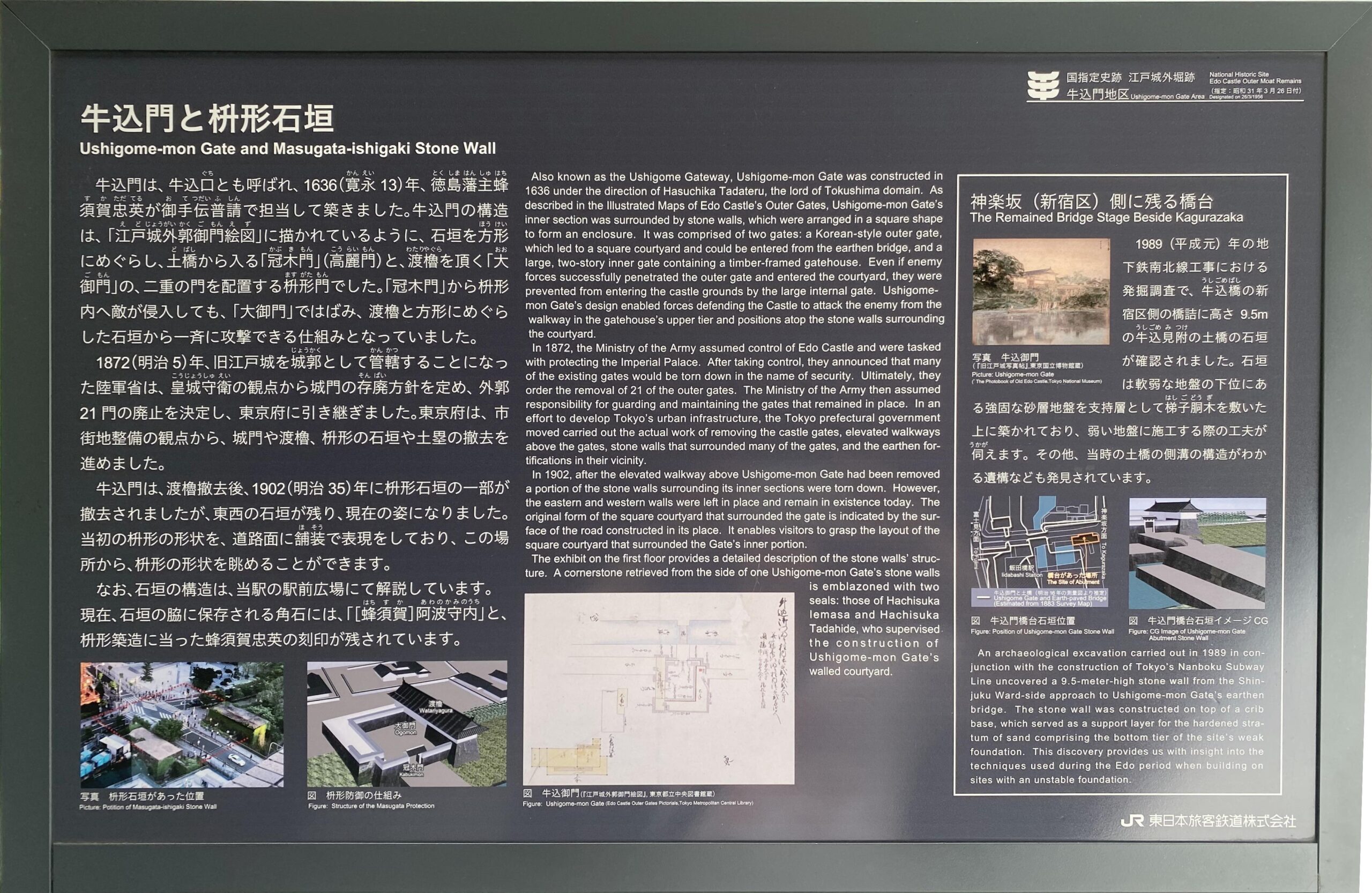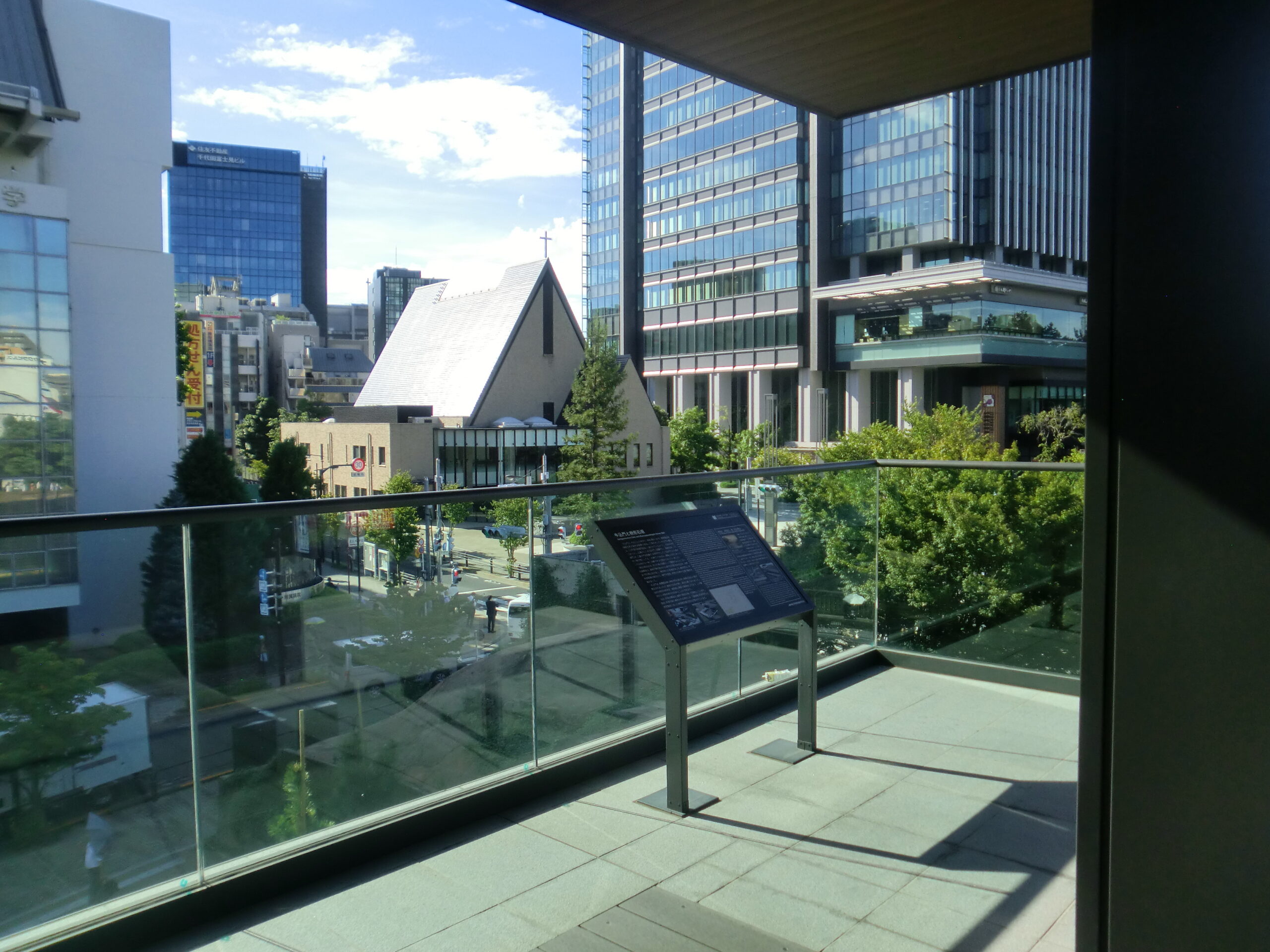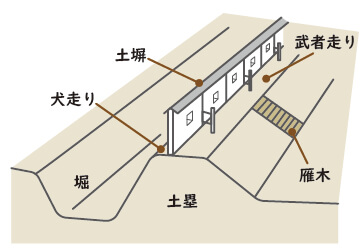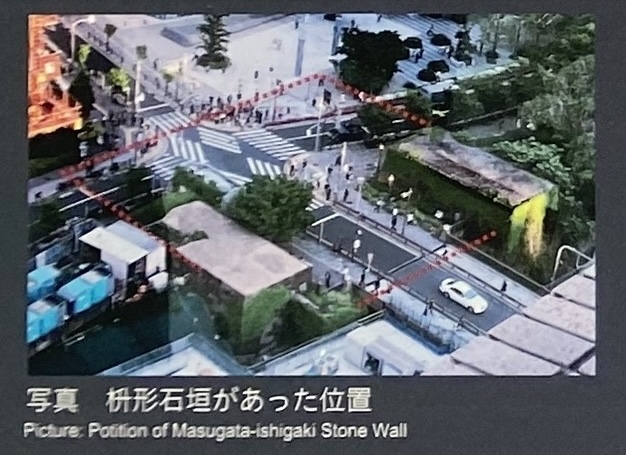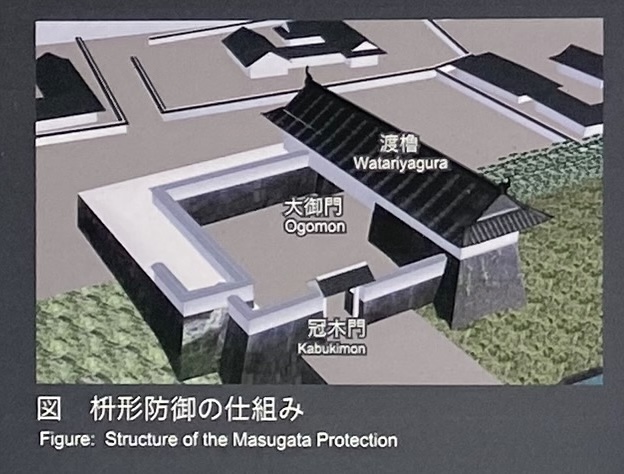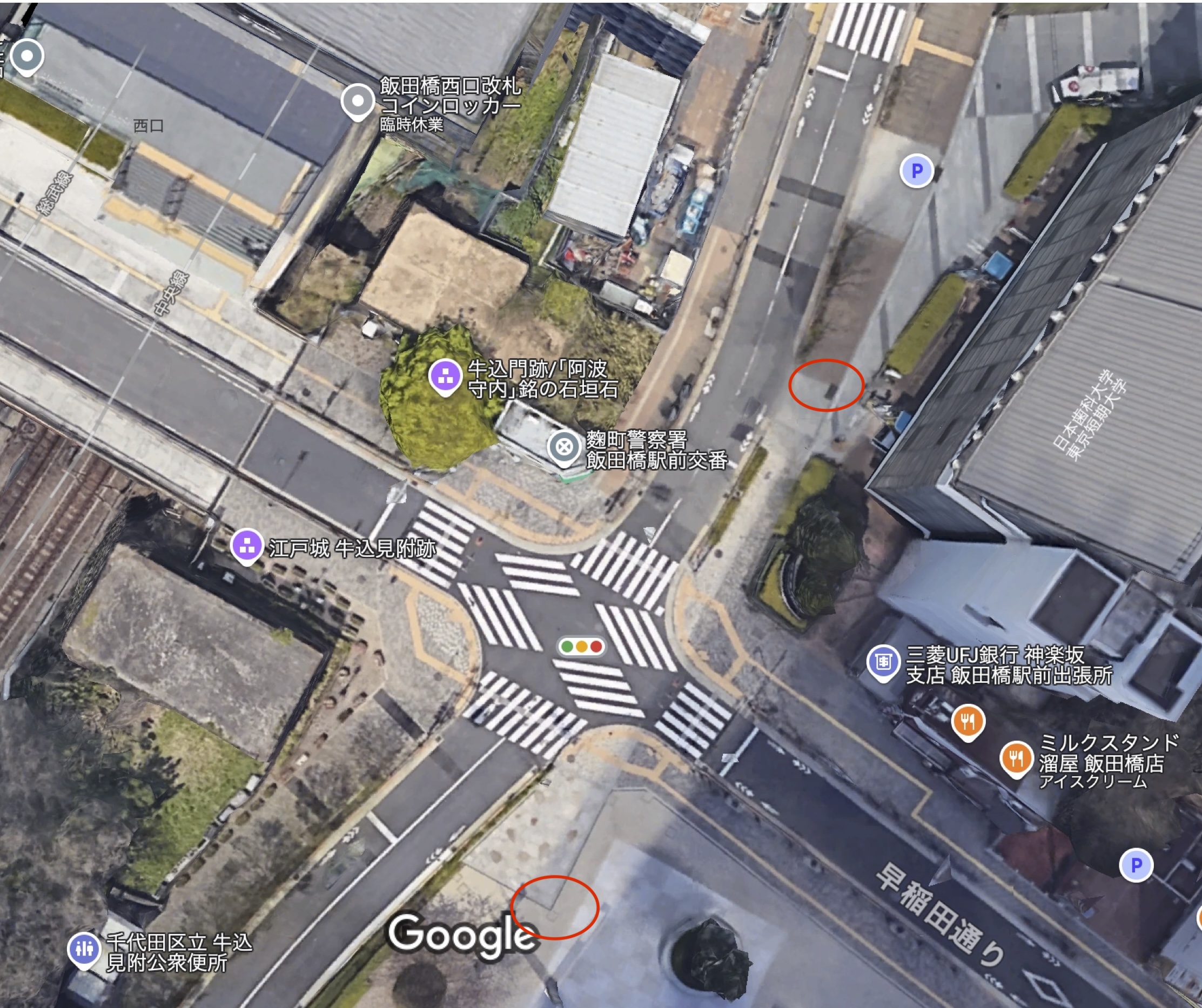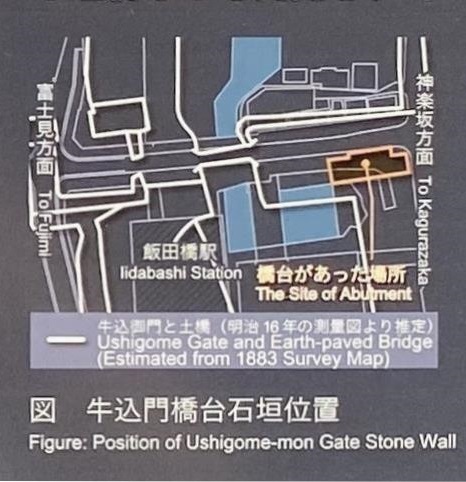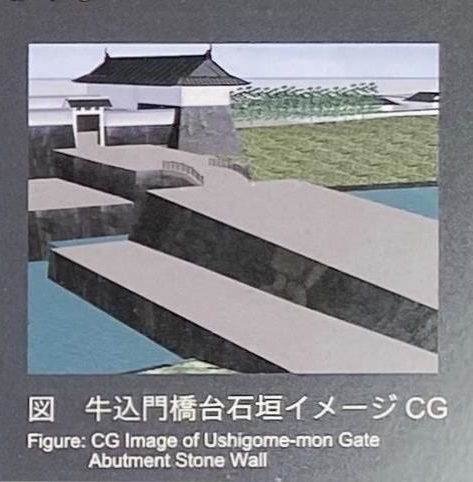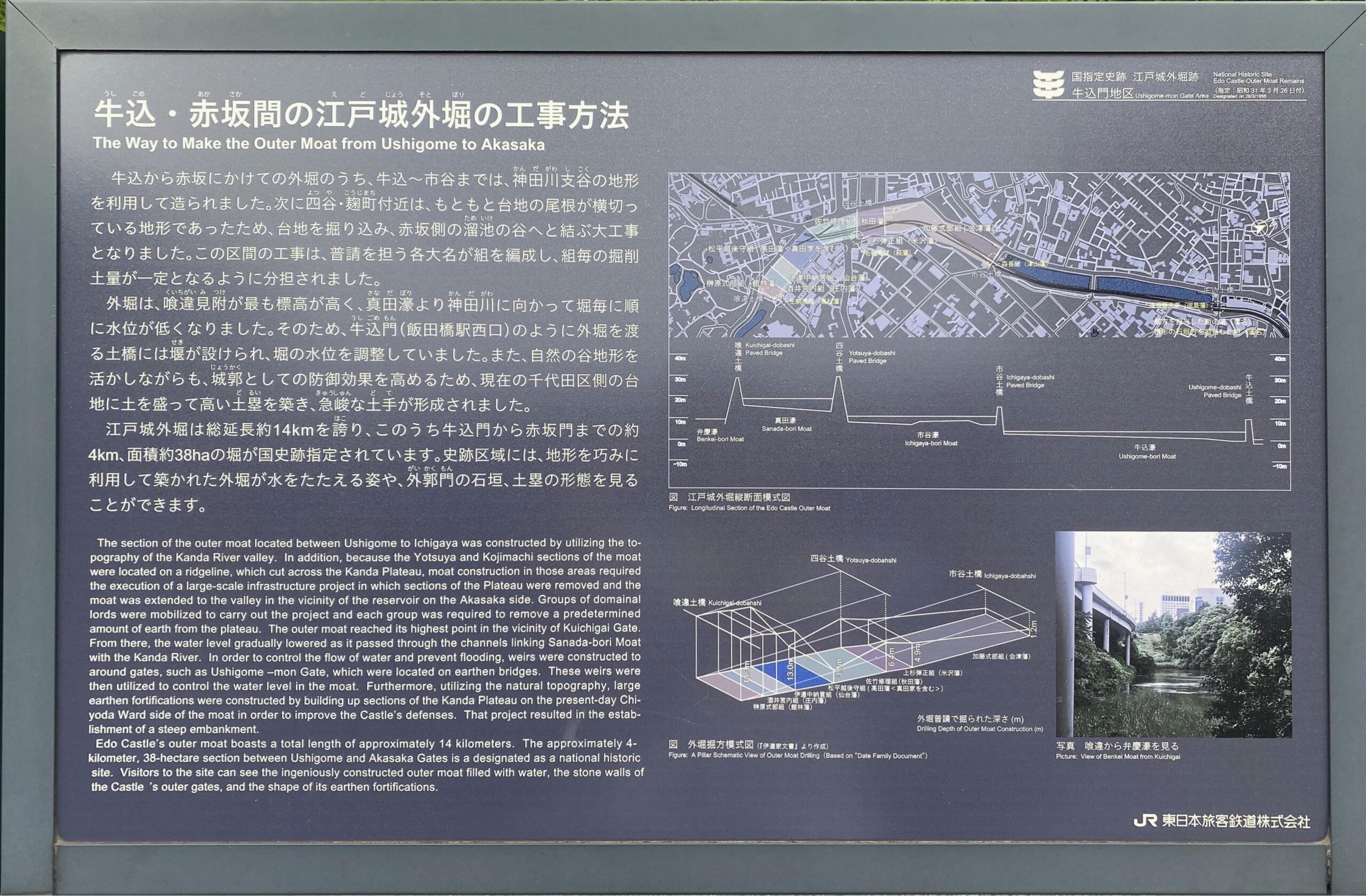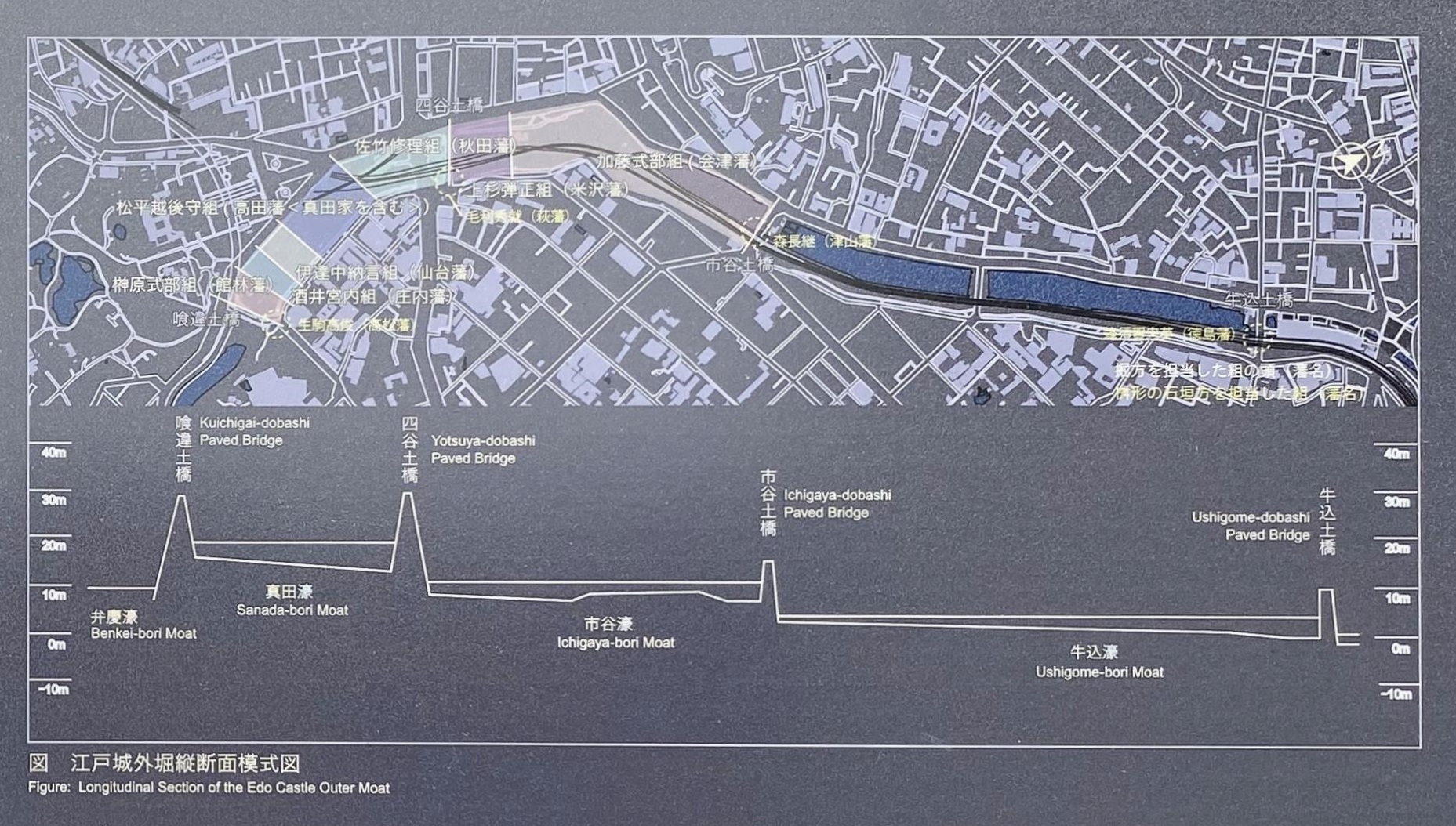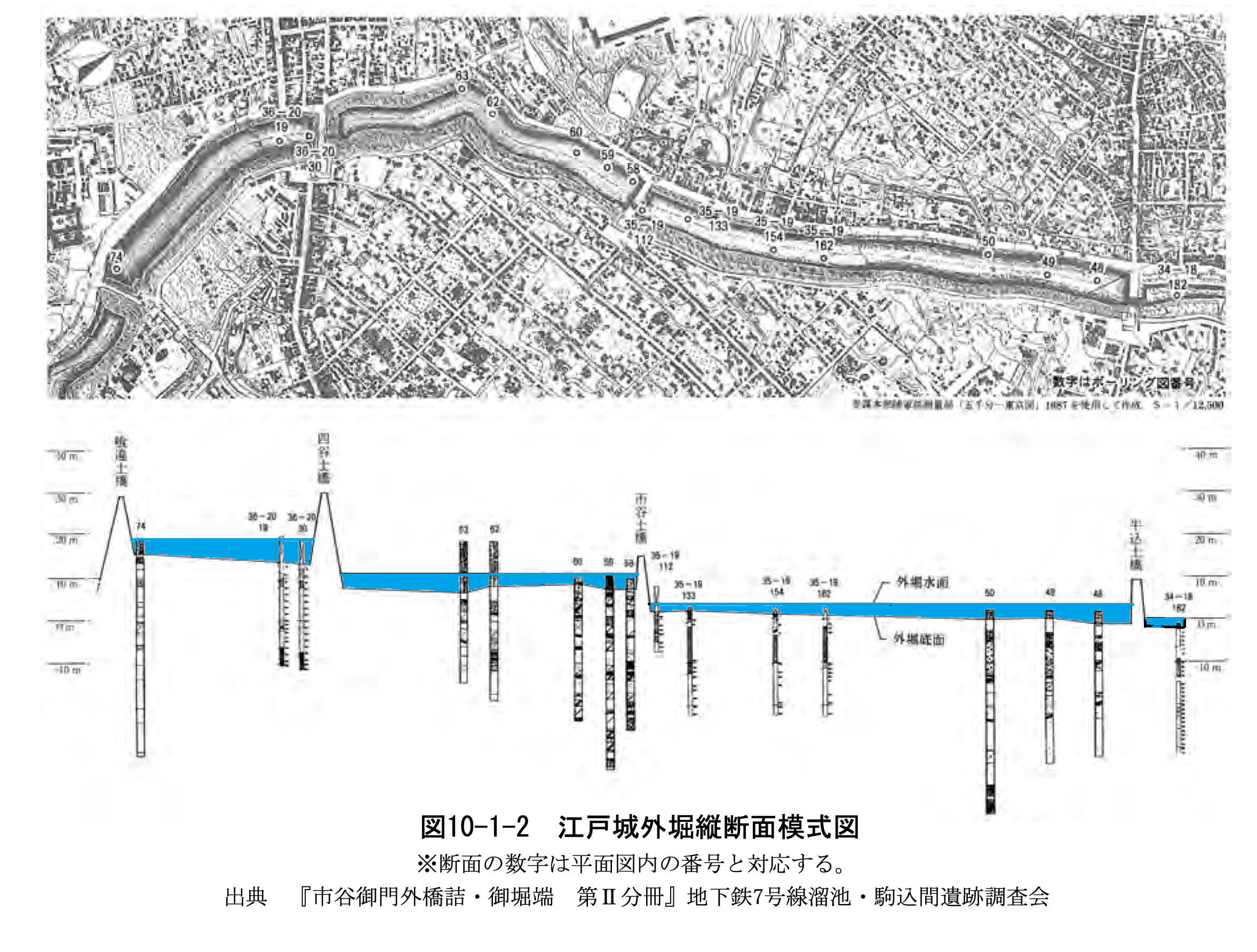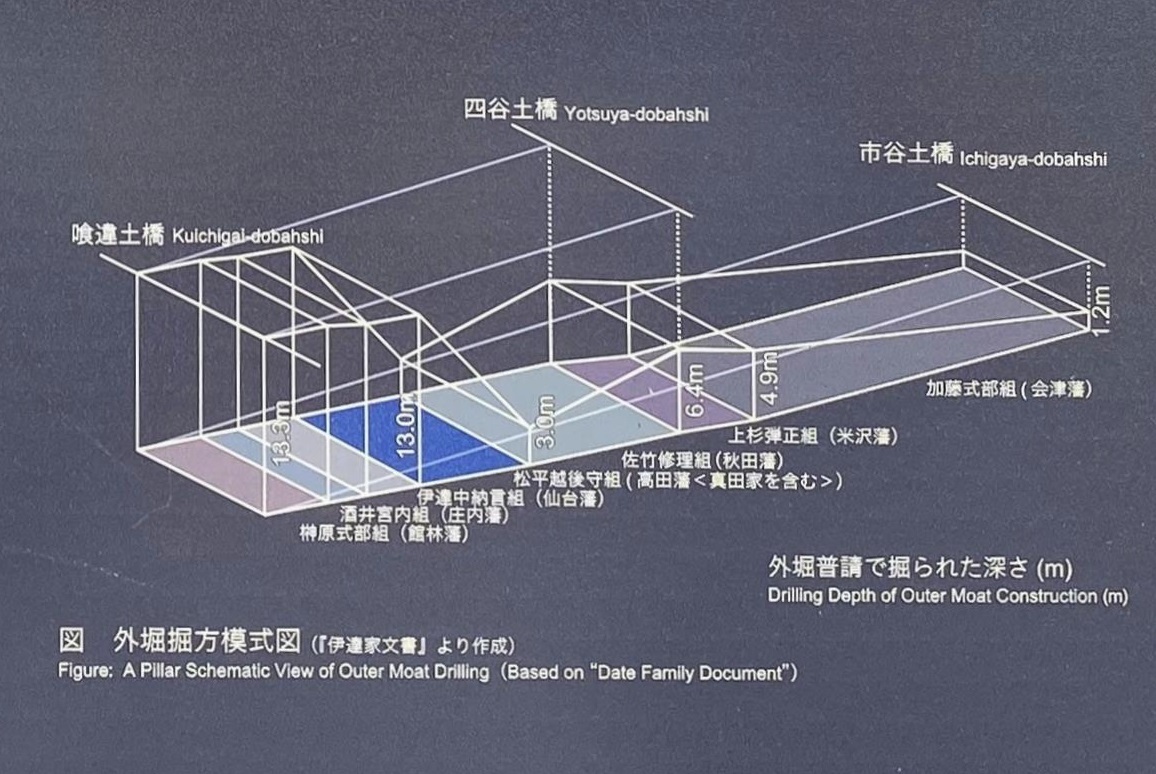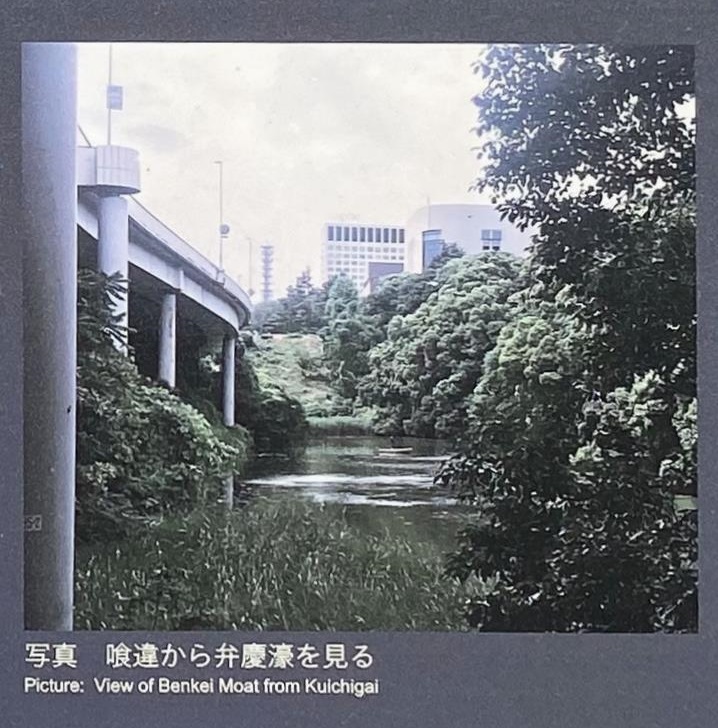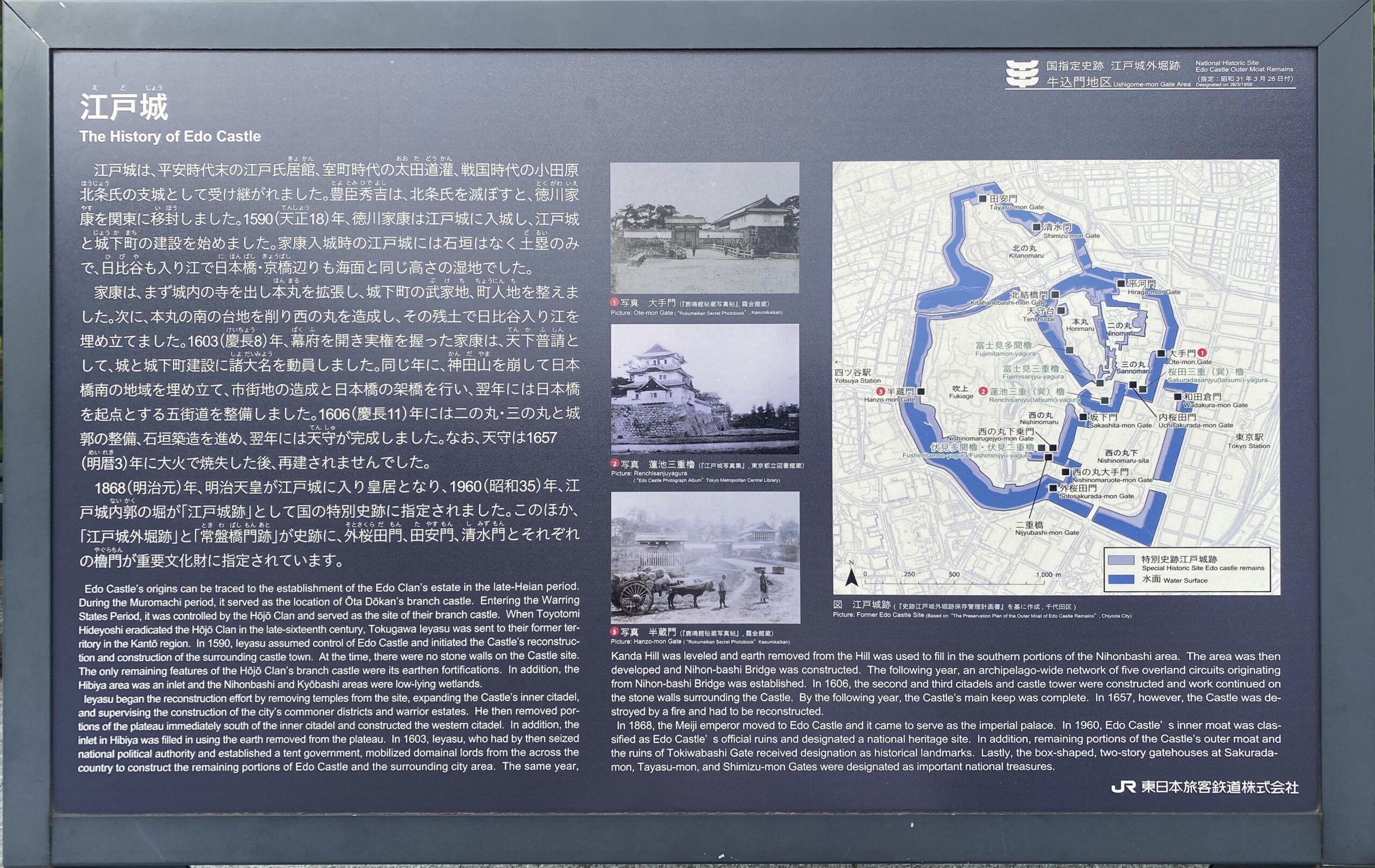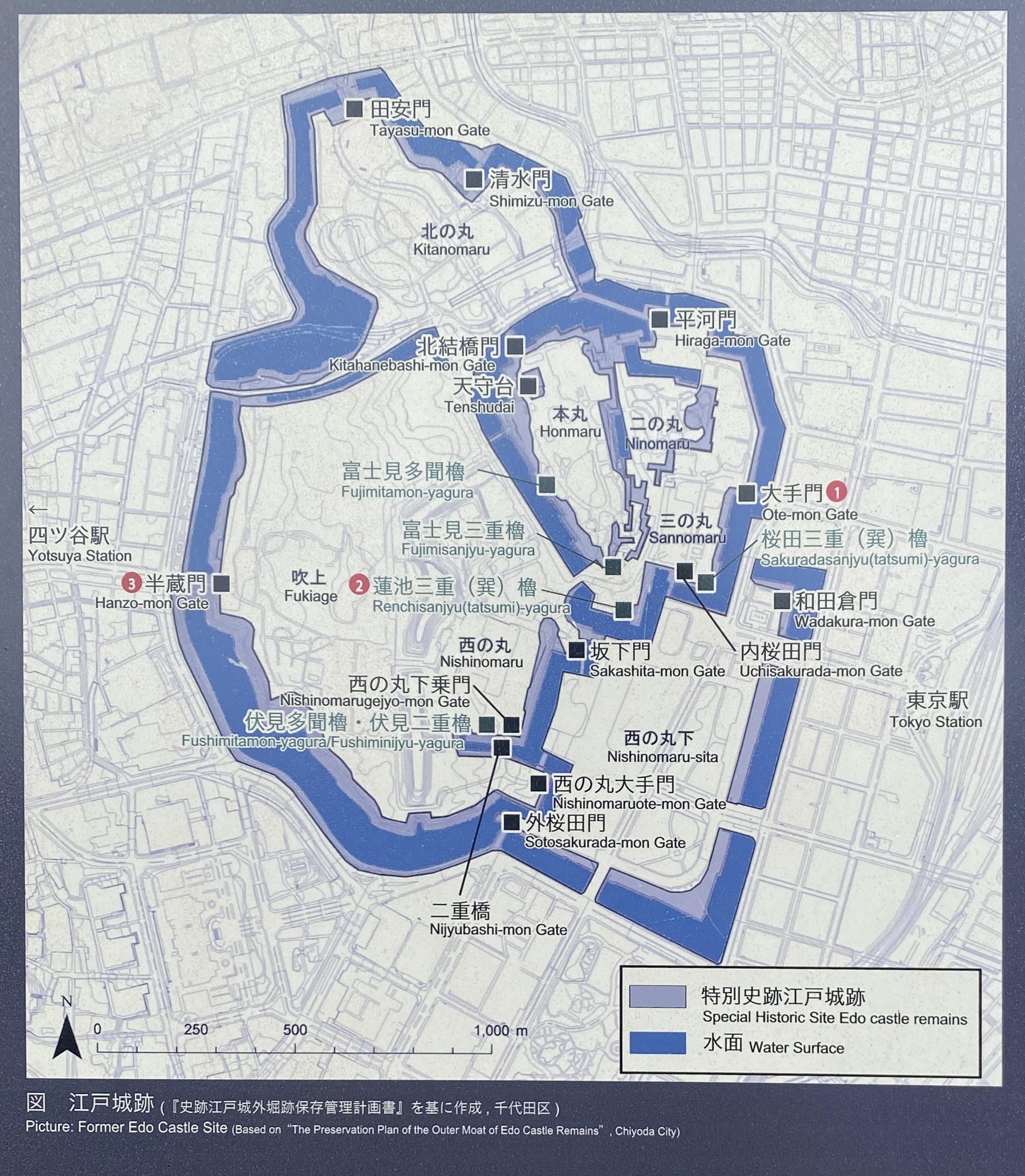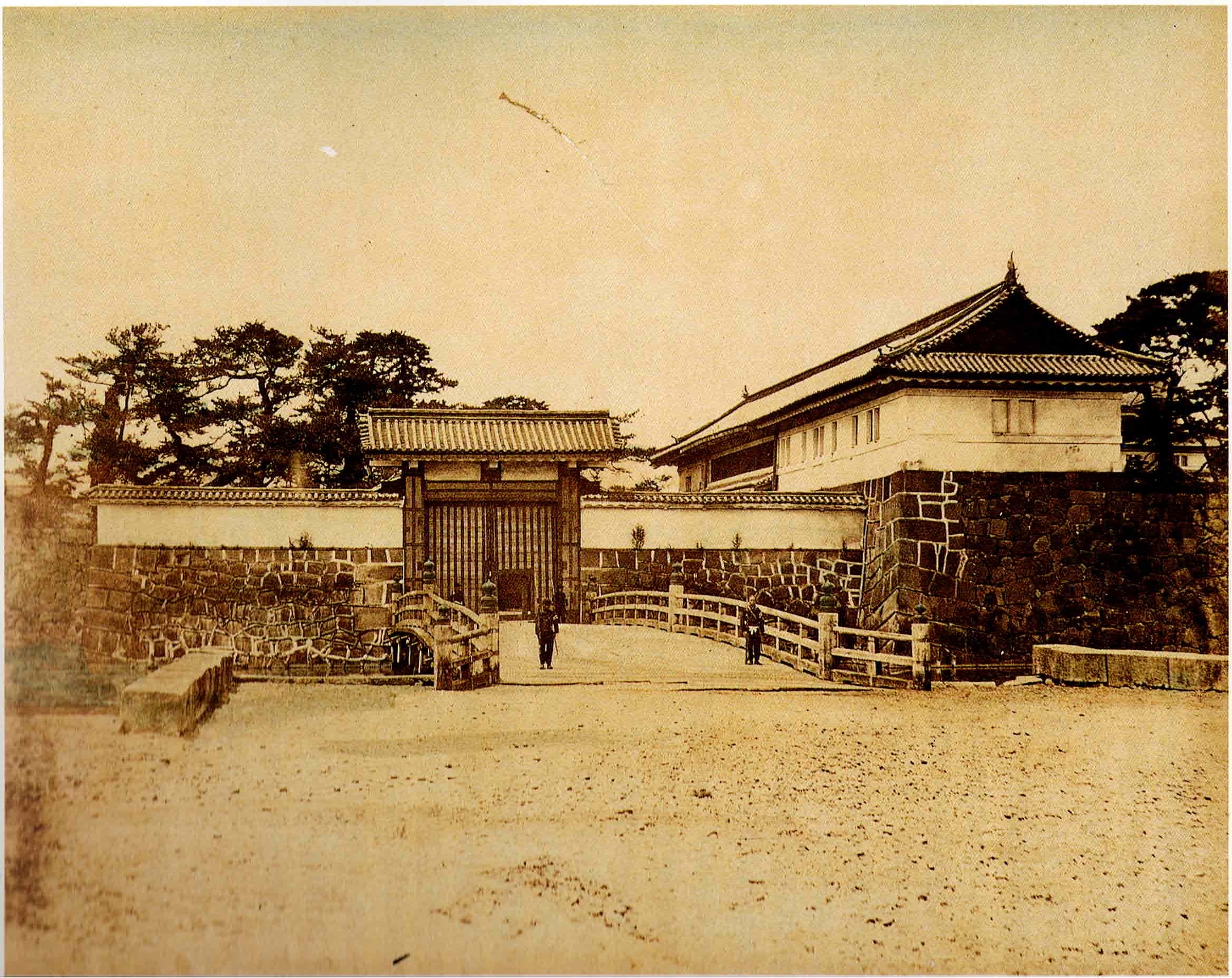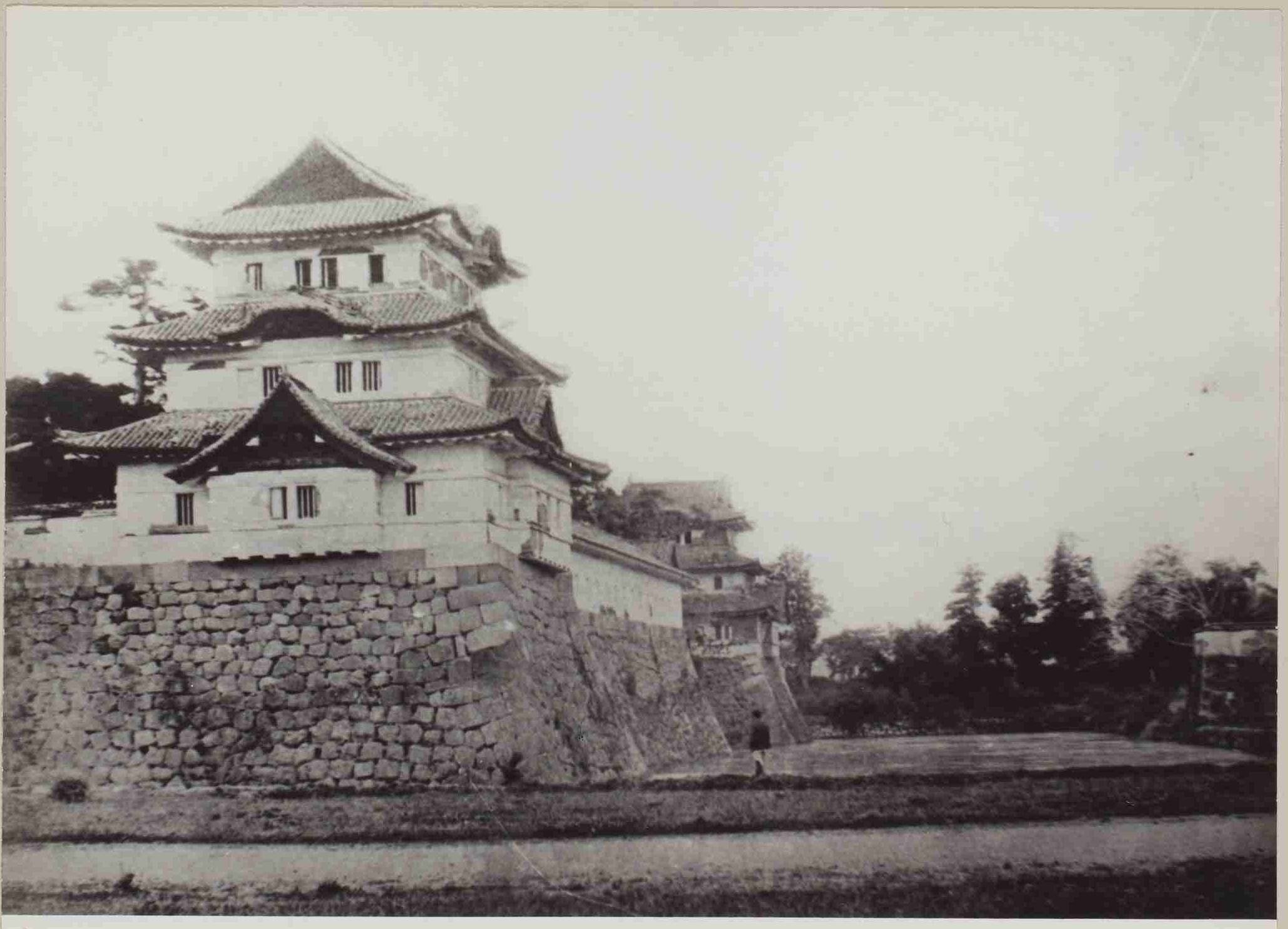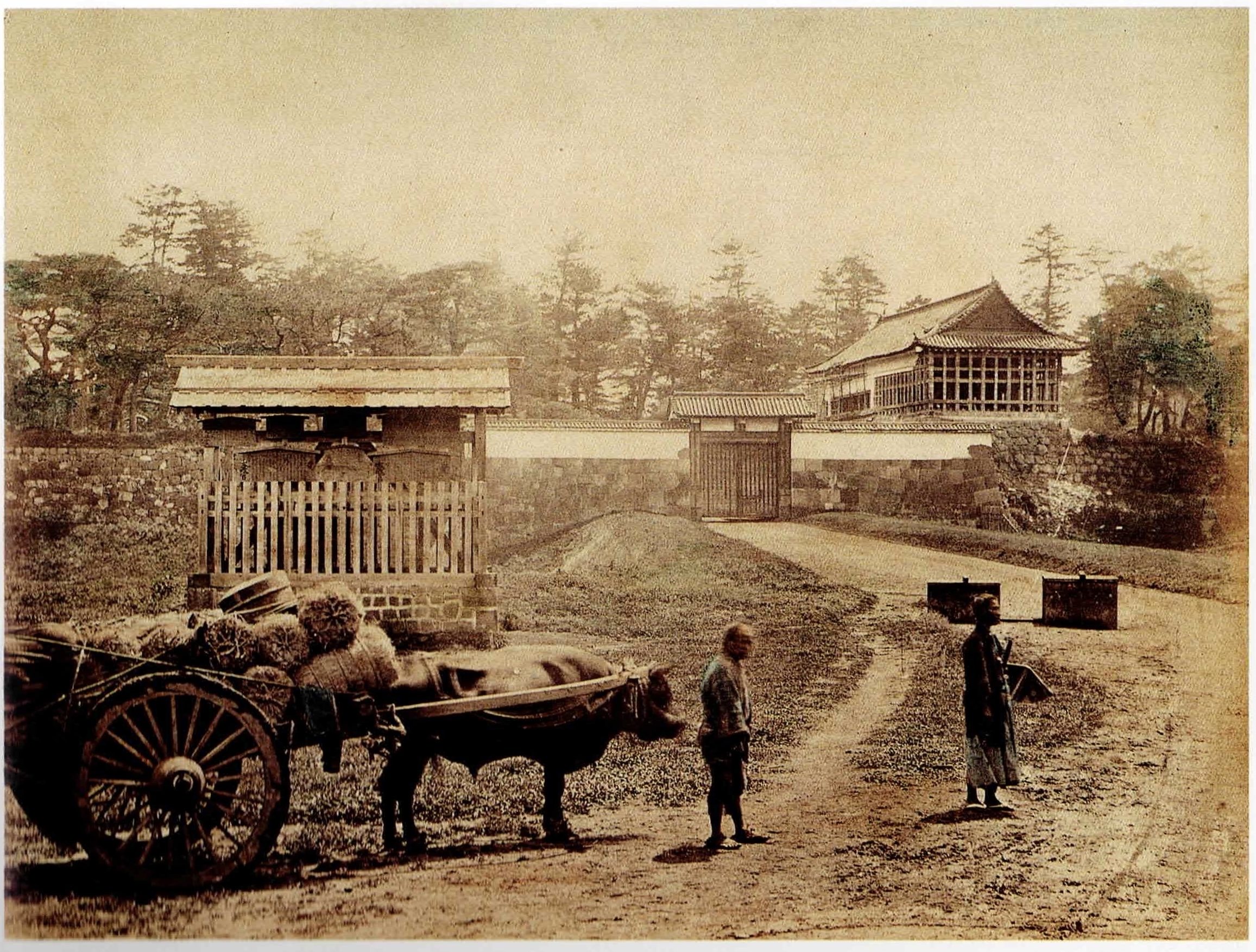2021年(令和3年)に飯田橋駅西口駅舎の2階に「史跡眺望テラス」ができ、「史跡紹介解説板」もできています。2階の主要テーマは「牛込門から牛込駅へ(鉄道の整備)」で、テラス東側にパネルが4枚(左から①、②、③、④)、さらに単独パネル(⑤)があります。これとは別に1階にも江戸城や外濠の「史跡紹介解説板」などができています。
パネル⑤「牛込門と枡形石垣」は他の4枚とは少し離れていて、テーマも「牛込門と枡形石垣」となり、「牛込門から牛込駅へ(鉄道の整備)」とは少々違っています。まあ「牛込門」だけは出ています。写真2枚と図4枚、うちコンピュータグラフィック(CG)は2枚、日本語と英語で解説しています。
| 牛込門は、牛込口とも呼ばれ、1636(寛永13)年、徳島藩主蜂須賀忠英が御手伝普請で担当して築きました。牛込門の構造は、「江戸城御門絵図」に描かれているように、石垣を方形にめぐらし、土橋から入る「冠木門」(高麗門)と、渡櫓を頂く「大御門」の、二重の門を配置する枡形門でした。「冠木門」から枡形内へ敵が侵入しても、「大御門」ではばみ、渡櫓と方形にめぐらした石垣から一斉に攻撃できる仕組みとなっていました。 1872(明治5)年、旧江戸城を城郭として管轄することになった陸軍省は、皇城守衛の観点から城門の存廃方針を定め、外郭21門の廃止を決定し、東京府に引き継ぎました。東京府は、市街地整備の観点から、城門や渡櫓、枡形の石垣や土塁の撤去を進めました。 牛込門は、渡櫓撤去後、1902(明治35)年に枡形石垣の一部が撤去されましたが、東西の石垣が残り、現在の姿になりました。当初の枡形の形状を、道路面に舗装で表現をしており、この場所から、枡形の形状を眺めることができます。 なお、石垣の構造は、当駅の駅前広場にて解説しています。現在、石垣の脇に保存される角石には、「[蜂須賀」阿波守内」と、枡形築造に当った蜂須賀忠英の刻印が残されています。 |
御手伝普請 豊臣政権江戸幕府が大名を動員して行った土木工事
江戸城御門絵図 江戸城御外郭御門絵図。江戸城外郭26図の全体図と番所の平面図を折本に仕立てたもの。奥書は享保2年 (1717)10月。
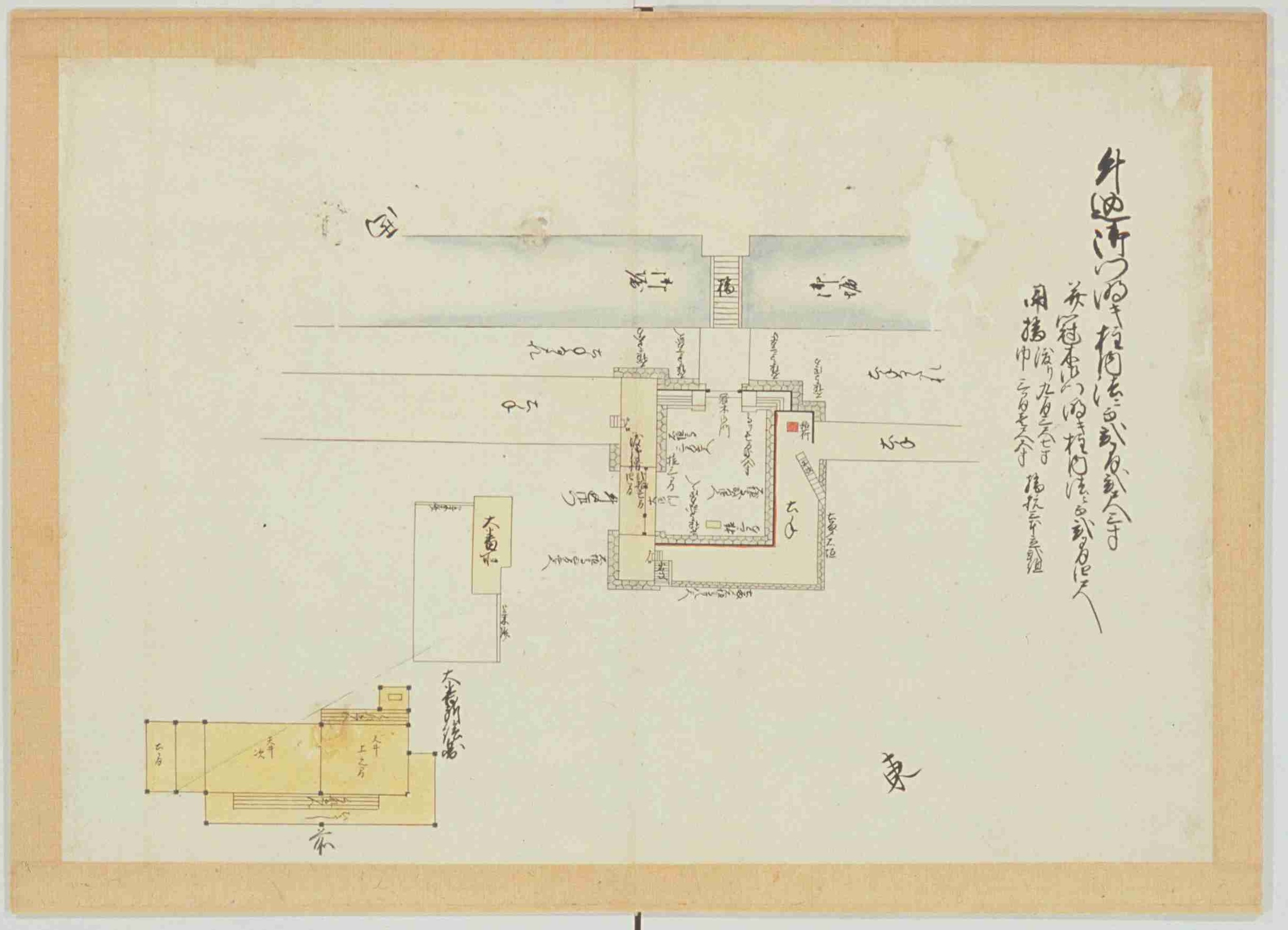
方形 四角形。
冠木門 左右の門柱を横木(冠木)によって構成した門
高麗門 正面左右の二本の本柱に切妻の屋根をかけ、これと直角に控柱を本柱の背後に立てて切妻屋根をかけたもの。城郭の外門などに多く見られる。
渡櫓 左右の石垣にまたがらせて造ったやぐら
大御門 おおみかど。「門」の尊敬語。特に皇居の門。
枡形門 ますがた。石垣で箱形(方形)につくった城郭への出入口。敵の侵入を防ぐために工夫された門の形式で、城の一の門と二の門との間にある2重の門で囲まれた四角い広場で、奥に進むためには直角に曲がる必要がある。出陣の際、兵が集まる場所であり、また、侵入した敵軍の動きをさまたげる効果もある。
城郭 城の周囲に設けた囲い。城壁。城と外囲い。外敵を防ぐための防御施設。とりで。
皇城 天皇の御所。宮城。皇居
土塁 どるい。土居。敵や動物などの侵入を防ぐため、主に盛土による堤防状の防壁施設。土を盛りあげ土手状にして、城郭などの周囲に築き城壁とした。英語ではembankmentで、土手、堤防、盛り土などがその訳語。
舗装で表現 実際の枡形石垣がいた場所を舗装の変化を使ってわかりやすくしています。
角石 方形に切った石。四角な石材。岩石学辞典では緻密で珪酸質の岩石の一般名
| Also known as the Ushigome Gateway, Ushigome-mon Gate was constructed in 1636 under the direction of Hasuchika Tadateru, the lord of Tokushima domain. As described in the Illustrated Maps of Edo Castle’s Outer Gates, Ushigome-mon Gate’s inner section was surrounded by stone walls, which were arranged in a square shape to form an enclosure. It was comprised of two gates: a Korean-style outer gate, which led to a square courtyard and could be entered from the earthen bridge, and a large, two-story inner gate containing a timber-framed gatehouse. Even if enemy forces successfully penetrated the outer gate and entered the courtyard, they were prevented from entering the castle grounds by the large internal gate. Ushigome-mon Gate’s design enabled forces defending the Castle to attack the enemy from the walkway in the gatehouse’s upper tier and positions atop the stone walls surrounding the courtyard. In 1872, the Ministry of the Army assumed control of Edo Castle and were tasked with protecting the Imperial Palace. After taking control, they announced that many of the existing gates would be torn down in the name of security. Ultimately, they order the removal of 21 of the outer gates. The Ministry of the Army then assumed responsibility for guarding and maintaining the gates that remained in place. In an effort to develop Tokyo’s urban infrastructure, the Tokyo prefectural government moved carried out the actual work of removing the castle gates, elevated walkways above the gates, stone walls that surrounded many of the gates, and the earthen fortifications in their vicinity. In 1902, after the elevated walkway above Ushigome-mon Gate had been removed a portion of the stone walls surrounding its inner sections were torn down. However, the eastern and western walls were left in place and remain in existence today. The original form of the square courtyard that surrounded the gate is indicated by the surface of the road constructed in its place. It enables visitors to grasp the layout of the square courtyard that surrounded the Gate’s inner portion. The exhibit on the first floor provides a detailed description of the stone walls’ struc-ture. A cornerstone retrieved from the side of one Ushigome-mon Gate’s stone wallsis emblazoned with two seals: those of Hachisuka lemasa and Hachisuka Tadahide, who supervised. the construction of Ushigome-mon Gate’s walled courtyard. |
| 神楽坂(新宿区)側に残る橋台 The Remained Bridge Stage Beside Kagurazaka 1989(平成元)年の地下鉄南北線工事における発掘調査で、牛込橋の新宿区側の橋詰に高さ9.5mの牛込見附の土橋の石垣が確認されました。石垣は軟弱な地盤の下位にある強固な砂層地盤を支持層として梯子胴木を敷いた上に築かれており、弱い地盤施工する際の工夫が伺えます。その他、当時の土橋の側溝の構造がわかる遺構なども発見されています。 An archaeological excavation carried out in 1989 in conjunction with the construction of Tokyo’s Nanboku Subway Line uncovered a 9.5-meter-high stone wall from the Shinjuku Ward-side approach to Ushigome-mon Gate’s earthen bridge. The stone wall was constructed on top of a crib base, which served as a support layer for the hardened stratum of sand comprising the bottom tier of the site’s weak foundation. This discovery provides us with insight into the techniques used during the Edo period when building on sites with an unstable foundation. |
梯子胴木 長手の木材に梯子のように短い木材を一定間隔で置いてつなげた工法
側溝 道路や鉄道の側端などに設けられる小水路排水のために設置される溝。道路にたまった雨水などを排水するためや、民地の用水路・排水路として設置する。
写真 牛込御門(「旧江戸城写真帖」東京国立博物館)
Picture: Ushigome-mon Gate (The Photobook of Old Edo Castle. Tokyo National Museum)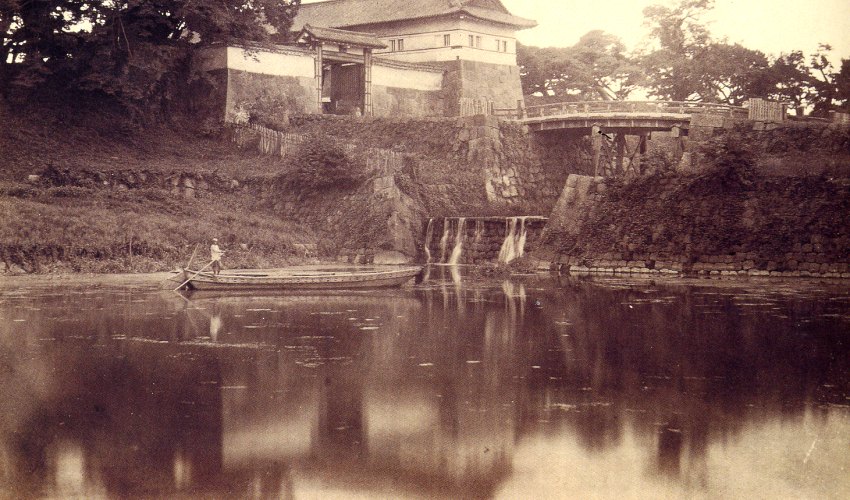
牛込門橋台石垣位置
橋台 きょうだい。橋の土台の部分。
牛込門橋台石垣イメージCG
